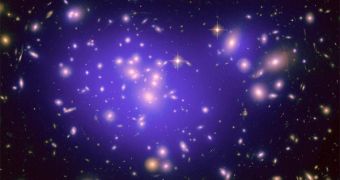A group of astronomers recently performed a highly-complex series of scientific studies, in which they use the gravitational lensing effect some galaxies have on incoming light beams to look for dark energy.
Nobody really knows what the stuff is, but existing theories say that it may be the force permeating the Universe, which causes galaxies to push away from each other at an ever-quickening pace.
It is also believed that dark energy is responsible for the expansion of the Cosmos itself, even though that idea has yet to be proven. Experts have yet to discover signs that dark energy actually exists.
Astronomers learned a long time ago that they can use the gravitational pull of a galaxy to conduct studies of celestial bodies located even farther.
That is to say, placing a large galaxy between us and the object of our studies causes light incoming from the latter object to pass through the gravitational field of the former, where mass distorts space and time, making the light appear magnified.
This process is called gravitational lensing, because it uses massive galaxies to “enhance” light that would otherwise be extremely dim.
Now, in a new study conducted with the NASA Hubble Space Telescope, researchers at the Yale University look at very distant galaxies through this observations process, in order to gain more clues as to how the geometry of space-time looks like in the Universe by default.
Hubble managed to identify and photograph 34 such galaxies. “The geometry, the content and the fate of the Universe are all intricately linked,” says Priyamvada Natarajan, a Yale researcher.
“If you know two, you can deduce the third. We already have a pretty good knowledge of the Universe's mass-energy content, so if we can get a handle on its geometry then we will be able to work out exactly what the fate of the Universe will be,” he adds, quoted by Space.
“Using our unique method in conjunction with others, we were able to come up with results that were far more precise than any achieved before,” explains Jean-Paul Kneib, a researcher on the study and an astronomer at the Laboratoire d'Astrophysique de Marseille, in France.
The team says that additional data on the geometry permeating the Cosmos were derived from past studies of supernova events, galactic clusters, black holes, and other types of structures.
Full details of the investigation appear in the August 20 issue of the esteemed journal Science.

 14 DAY TRIAL //
14 DAY TRIAL //